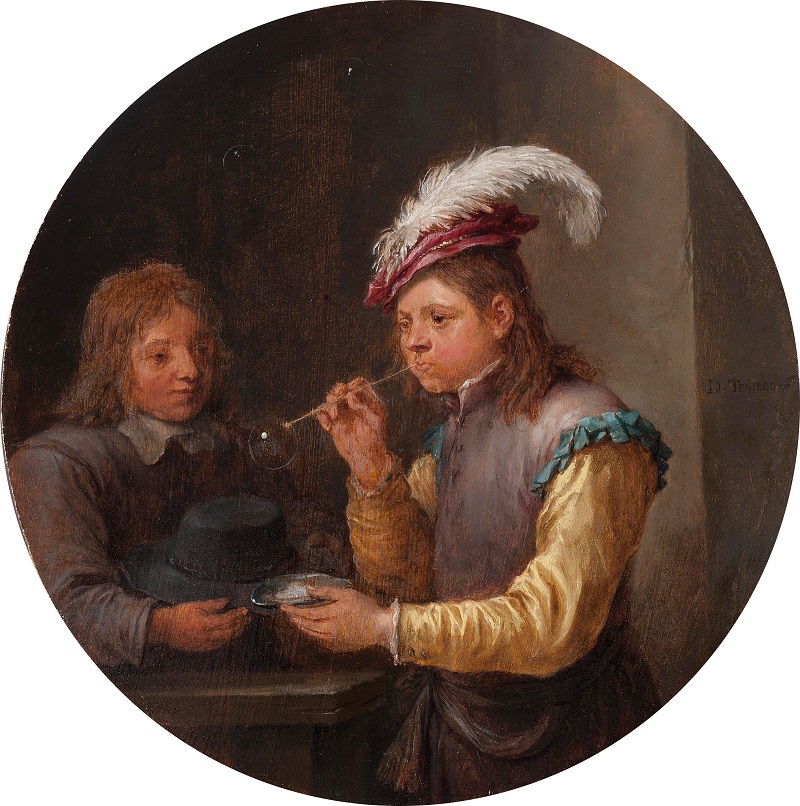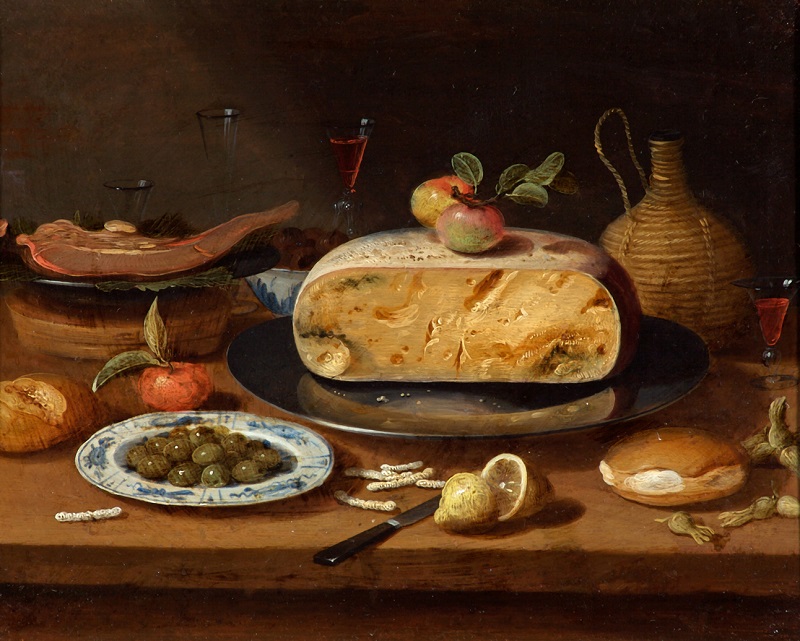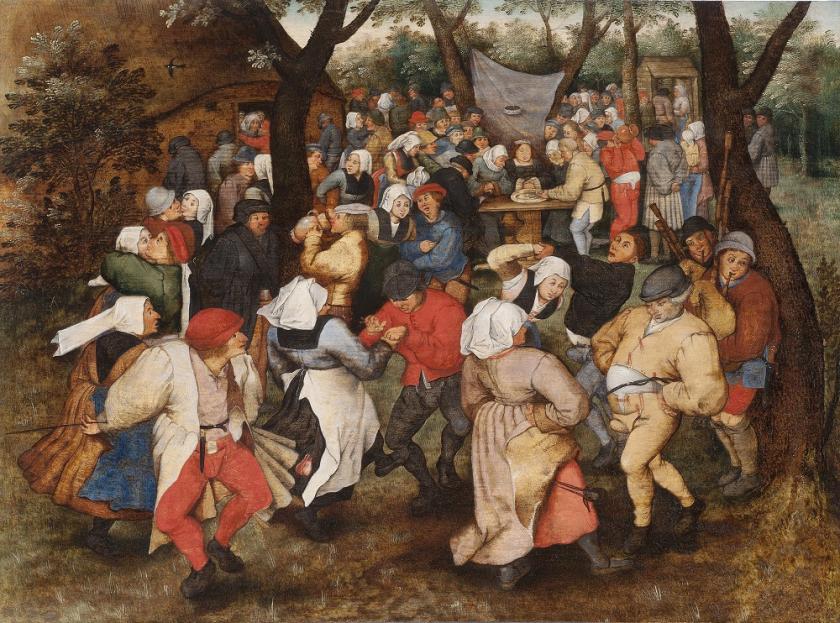Painted in c.1640, David Teniers the Younger’s Boy Blowing Bubbles depicts a theme that would have been entirely familiar to his wife’s great-grandfather, the founder of one of art’s most illustrious dynasties, Pieter Bruegel the Elder (c.1525-1569). Indicating the fleeting nature of life, the motif carries proverbial associations, its moral message one that in the 17th century was understood principally as memento mori. While Bruegel the Elder included depictions of proverbs in his panoramic scenes of peasant life, their meanings discussed and puzzled over by guests in the dining-rooms of the very wealthy, Teniers’ little roundel (pictured below right) adopts a format more in keeping with the tastes of a 17th century audience.
By the 1600s, Antwerp was not only the centre of the European art market, but a city in tune with the prevailing spirit of exploration and scientific enquiry. Its port must have been alive with exotic sights and sounds, as wonderful cargoes of animals, birds and plants arrived from all over the world. In the homes of wealthy connoisseurs, beautifully decorated cabinets housed collections of insects and other specimens, and whole rooms were dedicated to the display of art and objects of curiosity. David Teniers the Younger’s little painting could well have hung amongst detailed studies of insects and natural objects, antique coins and portrait miniatures, and an array of paintings, sculptures and prints.
 The painting is one of the stars of the collection of Dutch and Flemish paintings assembled by Sir William Holburne in the 19th century. Previously rejected, the attribution to Teniers has now been reinstated as the result of recent conservation work, and the painting now takes its place alongside the museum’s three paintings attributed to Pieter Brueghel the Younger. One of these, Wedding Dance in the Open Air, 1607-1614 (main picture), is also newly upgraded following the removal of discoloured varnish and detailed analysis of the underdrawing, whose quality and characteristics are said to be consistent with other versions of the painting by the artist.
The painting is one of the stars of the collection of Dutch and Flemish paintings assembled by Sir William Holburne in the 19th century. Previously rejected, the attribution to Teniers has now been reinstated as the result of recent conservation work, and the painting now takes its place alongside the museum’s three paintings attributed to Pieter Brueghel the Younger. One of these, Wedding Dance in the Open Air, 1607-1614 (main picture), is also newly upgraded following the removal of discoloured varnish and detailed analysis of the underdrawing, whose quality and characteristics are said to be consistent with other versions of the painting by the artist.
Upgraded attributions to individual, prestigious artists might help to promote the Holburne Museum's fine collection, but in exploring the ways in which, over several generations, the Bruegel dynasty sustained certain images, themes and techniques, the exhibition highlights the limitations of modern notions of authorship.
 It was in meeting the demands for works by their late father that Jan and Pieter Brueghel the Younger began to establish a degree of what today might be recognised as brand identity, producing copies and adaptations of Bruegel the Elder’s most sought-after works. While Wedding Dance in the Open Air was one of Pieter Brueghel the Younger’s most popular works, with over 30 versions attributed to his hand and many further copies in existence, including by his brother, Jan Brueghel the Elder, it probably wasn’t his own composition. It was a popular subject for his father Bruegel the Elder, too, and it seems likely that Pieter and Jan took their design from a cartoon inherited from their father.
It was in meeting the demands for works by their late father that Jan and Pieter Brueghel the Younger began to establish a degree of what today might be recognised as brand identity, producing copies and adaptations of Bruegel the Elder’s most sought-after works. While Wedding Dance in the Open Air was one of Pieter Brueghel the Younger’s most popular works, with over 30 versions attributed to his hand and many further copies in existence, including by his brother, Jan Brueghel the Elder, it probably wasn’t his own composition. It was a popular subject for his father Bruegel the Elder, too, and it seems likely that Pieter and Jan took their design from a cartoon inherited from their father.
Cartoons, preparatory drawings, and their father’s paintings were essential to the training of Jan and Pieter, who were infants when Bruegel the Elder died in 1569, but it was their grandmother Mayken Verhulst (1518-1599), an accomplished but now obscure miniaturist, who taught them to paint. Her legacy can be seen not only in the works of Jan Brueghel the Elder, whose exquisitely fine paintings on copper earned him the nickname "Velvet Brueghel", but also in the minutely detailed paintings made by Jan's grandson, Jan Van Kessel (pictured above: Circle of Jan Van Kessel the Elder, Still-Life with Cheese, c.1650). In tracing the characteristics of this remarkable family of artists, we are afforded a tantalising glimpse of an alternative history of art, enriched with the forgotten women artists of the past.
- Bruegel: Defining a Dynasty at the Holburne Museum, Bath until 4 June
- A book to accompany the exhibition is published by Philip Wilson Publishers, £16.95
- Read more visual arts reviews on theartsdesk










![SEX MONEY RACE RELIGION [2016] by Gilbert and George. Installation shot of Gilbert & George 21ST CENTURY PICTURES Hayward Gallery](/sites/default/files/styles/thumbnail_125_x_125_/public/mastimages/Gilbert%20%26%20George_%2021ST%20CENTURY%20PICTURES.%20SEX%20MONEY%20RACE%20RELIGION%20%5B2016%5D.%20Photo_%20Mark%20Blower.%20Courtesy%20of%20the%20Gilbert%20%26%20George%20and%20the%20Hayward%20Gallery._0.jpg?itok=3oW-Y84i)




Add comment